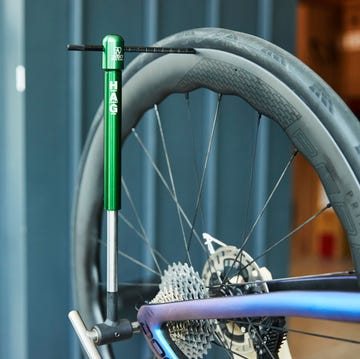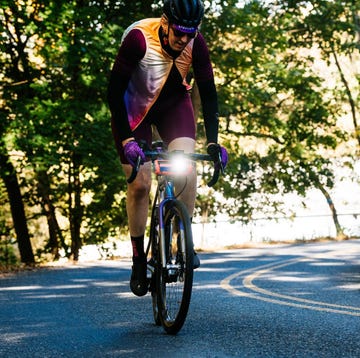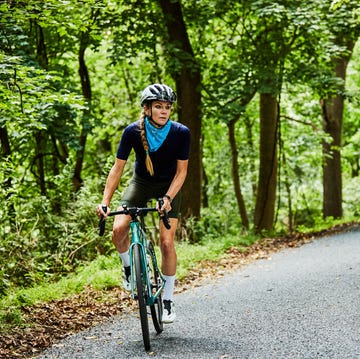Even if you’re not completely familiar with your power or heart rate training zones, you’ve probably heard that you should spend a majority of your time in the saddle riding at an effort that allows you to chat with your cycling buddies. This intensity, known as zone 2 training, provides a bunch of payoffs in terms of fitness and performance.
Also referred to as the aerobic zone, conversational pace, or all-day pace—though those titles can be slightly misleading—this effort can get confusing to master.
To help you conquer it, we explain exactly what zone 2 training means, why it matters, how it can help your performance, and how to do it for maximum gains.
The Benefits of Zone 2 Training
Considered the leading global expert on all things zone 2, Iñigo San Millán, Ph.D., has spent three decades studying the effects of training in this aerobic zone. The former cyclist has worked with clinical populations dealing with diabetes, and he’s working with the upper echelon of the cycling world.
When he spoke to Bicycling a while back, he was in the middle of a rainstorm in France after chasing Tadej Pogačar up a Tour de France climb. “Let’s be clear,” he joked. “A normal person would be in zone 5 trying to keep up with Pogačar in his zone 2.”
That’s the just beginning of the nuances around this aerobic zone that’s gotten so much press coverage in recent years. (This fact bemuses San Millán, as someone who spent decades toiling away in labs and in the field on this work before it went viral.)
Before we get into the how to do zone 2 training, let’s briefly dig into the science side, which explains why it’s so important.
San Millán’s original interest in zone 2 came when he realized that optimal cellular mitochondrial function (the powerhouse of our cells) is key for both health and performance.
While you can’t see your mitochondria making moves when you exercise, you can feel how well your muscles clear lactate that’s produced by more intense exercise. “When you don’t clear lactate correctly, it builds up in the blood, and that’s a sign that your mitochondria are not keeping up very well,” says San Millán.
He started to notice that training more in the aerobic-based zone 2—the zone where the body produces lactate but is able to clear it equally quickly—allowed athletes to better clear the lactate from their muscles when they did increase their intensity and lactate production. Essentially, training at this lower intensity allowed them to train harder at higher intensities.
The same effect applies to pro athletes and recreational cyclists: Training that aerobic zone where the body is burning fat rather than glycogen improves both performance and health outcomes, thanks to how it improves mitochondrial function.
What makes zone 2 training particularly interesting is that it’s one of the few training stimuli that’s as good for health and longevity as it is for performance. San Millán’s research has found that many clinical populations—those with certain cancers, type 2 diabetes, and other metabolic diseases—have significant mitochondrial dysfunction.
While exercise alone isn’t a cure-all, San Millán found that adding in a protocol of zone 2-based exercise led to significant health improvements for those populations. Meanwhile, it also makes top pros like Pogačar get up hills faster.
Misconceptions About Zone 2 Training
Because it’s become so popular, there are many misconceptions around zone 2 training.
For starters, there’s the question of “what is zone 2?” Most people will say it’s all-day pace, conversational pace, or refer to it as LSD (long slow distance). But often, the pace you’re riding at in zone 2 is a bit harder than you may think. “You should be able to hold a conversation,” says San Millán. “But it shouldn’t be easy to do so. If it’s easy to chat, that’s more zone 1 recovery versus zone 2.”
It’s also not that slow. Again, see Pogačar’s “all-day pace,” which is likely faster than most of us could do on our best threshold testing day.
On the flip side, popular health and wellness blogs who’ve honed in on zone 2 will talk about walking as a great way to get in some zone 2 exercise. That may work for someone who doesn’t regularly exercise, but if you are training regularly, you’ll need to make that walk pretty brisk in order to move from zone 1 training into zone 2.
In other words: Zone 2 is different for everyone. The most important thing is to pay attention to your own effort to make sure you’re hitting the right intensity.
Also, if you got interested in zone 2 for health reasons, you may think that it’s all that you ever need to do. However, San Millán is quick to point out that while it’s the building block for cyclists, you do still need to do intervals and harder efforts if you want to make gains in your cycling. After all, if you never go hard, why did you bother improving that mitochondrial function that allows you to push the intensity in the first place?
While zone 2 trains you to be efficient at burning fat, once you get above that zone, you start burning glucose for fuel—and that’s something you need to train your body for, rather than hoping that on race day, you’ll magically be really good at going hard after training solely in zone 2.
How to Find Your Zone 2 Pace
The ultimate test for finding your zone 2 pace is a lactate test, because zone 2 is where your body is clearing the lactate you produce during exercise, not letting it accumulate.
While in an ideal universe, San Millán would send you to a lab for lactate testing in order to find your zone 2 pace, you can also base it off of your functional threshold power or heart rate. (Use this chart to help determine your pace.)
However, San Millán believes that FTP tests aren’t a perfect power-setting option when it comes to zone 2. Use that as a starting point, but make sure the power or heart rate matches up with the correct feeling: Your zone 2 pace should be sustainable for a few hours, and you should be able to hold a conversation, though it shouldn’t feel easy to do so.
Kristen Legan, gravel cycling coach and winner of the 350-mile Unbound XL in 2023, knows a thing or two about spending a lot of time in zone 2. When you’re training for races like the XL, most of your time is spent in the aerobic zone, though as with racers like Pogačar, she does need to spend some time going really freaking fast.
She says that even if you aren’t riding for six hours, it should feel like you could if you wanted to. “Zone 2 is the pace that you can sustain for a really long time—as long as you’re eating and drinking!” says Legan. (Often, the reason zone 2 starts to feel harder as the ride gets longer is fuel-based, not leg- or lung-based.)
However, while this sounds like the ride should be easy, don’t confuse conversational with “easy pace.” “Zone 1 is a recovery or easy ride,” says Legan. “In these rides, you’re in easy gears, you’re really relaxed, and the goal is just getting your body moving. It’s not about pressure on the pedals. Zone 2 is a bit harder than that.”
How to Actually Stay in Zone 2 on Rides
“You can pay attention to your heart rate monitor or power meter to make sure you’re staying in the zone if you aren’t comfortable with relying on your perceived exertion,” says Legan. “But I think just trying to keep that conversational pace—testing out talking while you’re riding if you need to check in—is the best way to ensure you stay in the zone.”
To be quite honest, zone 2 can take some practice to perfect, considering it runs the fine line right between going too easy and going too hard. Don’t get discouraged if you struggle with it at first!
“It takes practice to do zone 2,” says Legan. “But the more you do it, it will become easier and easier to just fall into it rather than staying in the easier zone 1 or ratcheting up to zone 3 or higher.”
“As athletes, I think a lot of us hate that feeling of needing to shift down, because we just want to be pushing all the time, and we want to feel like we’re getting work done,” says Legan. “It takes mental practice to just be okay with not trying to speed up a hill.”
Don’t forget, outside influences can affect your zone 2 pace, too—it’s not a steady marker, says San Millán. In heat or at altitude, for example, you may see a 10 percent decrease in the power you’re able to hold while staying within your zone 2 heart rate, because the environment is also taxing the body.
The Ideal Amount of Time to Spend Training in Zone 2
“Ideally, someone would be training three to four days a week in zone 2,” says San Millán. “But these sessions don’t need to be as long as you might think. People always assume zone 2 rides need to be three or more hours to ‘count,’ but even 90 minutes in zone 2 will show good results.”
If you are hoping to do longer races, obviously adding more volume on some rides will be beneficial, but that 90 minutes can improve your mitochondrial function.
For most cyclists, Legan says that the breakdown of hours spent in zone 2 should be about 80 percent of time there, with 20 percent spent in intervals and recovery from said intervals. “Whether you’re a crit racer, road racer, or a gravel racer, that breakdown works—you just do different intervals in the other 20 percent of your time. But the biggest physiological boost comes from that time in zone 2,” she says.
When you’re on a zone 2 ride outside, don’t panic if you go slightly above or below your zone as you go up a hill (or descend down one). Get comfortable shifting into an easy gear and spinning away on hills to keep your effort as close to zone 2 as possible, but San Millán says that even if 80 percent of your ride is in zone 2, that’s a good ride!
When to Expect to See Results from Zone 2 Training
Like most things, training in zone 2 takes time before you see major benefits. “You’ll start getting some adaptations after a couple of months if you’re training in zone 2 consistently,” San Millán says. But the real improvements come after a year of keeping your zone 2 training consistent, while still adding in intervals and high-intensity work occasionally.
“I compare training in zone 2 to planting a vineyard,” he adds. “In the first season of planting, you’re not going to have any harvest even if you do all the right preparation. You’ll see some vines, you’ll see that it’s coming, but you won’t have grapes yet. But the second year... that’s when you have that first harvest.”

Molly writes about cycling, nutrition and training with an emphasis on bringing more women into sport. She's the author of nine books including the Shred Girls series and is the founder of Strong Girl Publishing. She co-hosts The Consummate Athlete Podcast and spends most of her free time biking and running on trails, occasionally joined by her mini-dachshund.

David Lipscomb is the Bicycling membership coach and owner of CIS Training Systems in New York City.













